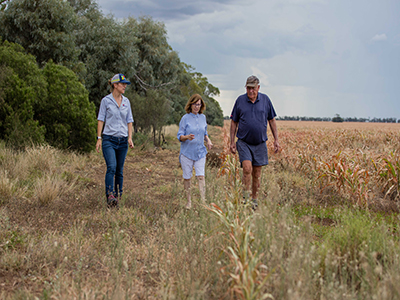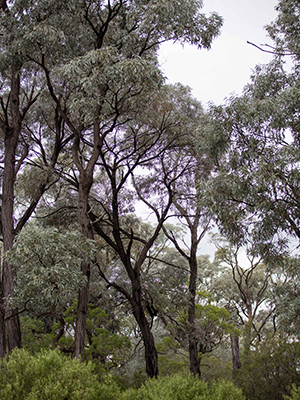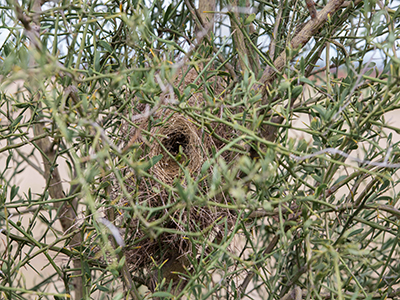Valuing, preserving and protecting brigalow woodland
The Mungle Scrub is a special place for landholders Kerrie and Tim Hayes, who have been working to maintain precious remnants of brigalow woodland on their farm, which is among other things, home to one of the rarest butterflies in Australia.
‘Girrahween’ is located along the Newell Highway between Moree and Goondiwindi, on the western edge of what was known as the Mungle Scrub in North West NSW. While known locally as ‘scrub’ it is described as woodland with predominantly brigalow, along with belah, myall, wilga, various grasses and native vines. In its original state, the Mungle Scrub covered just over 150,000 acres, stretching from the Newell at its western edge, north to around Boggabilla, south to Moree and east towards Warialda. Today, only remnants remain, with brigalow woodland now classed as a endangered ecological community in NSW and threatened nationally. The area covered by the former scrub now comprises some of the most desirable farming land in the state.

It was the foresight of Kerrie’s grandfather and father who initially set aside a portion of Girrahween to be kept in its natural state back in the 1950s. Kerrie and Tim continue this legacy, with 450 hectares of timberlines and retained areas remaining in a very healthy state. They say over time they’ve come to know the scrub well as it moves through seasons and cycles.
“The wet times aren’t what it is all about,” Tim says, “the dry times are also a big part of what makes it tick.
“With the great season we’re having you won’t see this country look better, but for example it was the stress and death of some of the larger brigalows during the recent drought that caused them to sucker and create this great understory we have here.
“Conversely the belah like it when water is laying around to see new trees.
“Sadly in the drought our bird population got down to around five to ten per cent of levels in good times.
“Thankfully we’ve seen them return, including some I’m seeing for the first time, like blue-faced honeyeaters and singing honeyeaters.”
Over the years they’ve worked with various bodies in an effort to preserve the scrub, and are now working with Local Land Services in managing weeds and working to better understand the role this unique ecosystem plays in their farming business.

Brigalow woodland provides habitat for a large number of species, including 17 fauna species that are threatened as well as providing ecosystem services (including carbon storage, habitat for pollinators, erosion and salinity control). Brigalow woodland is predominantly under threat from clearing and fragmentation, overgrazing, spray drift and invasive species.
With funding from the Australian Government’s National Landcare Program, North West Local Land Services is helping to maintain and protect remaining brigalow stands across the region.
Senior Land Services Officer Pip Jones has been working with landholders such as Kerrie and Tim on targeted management actions including successful weed control focussing on African boxthorn, tree pear, mother of millions and harrisia cactus. They have also engaged CSIRO scientists to monitor insect populations in the woodland and cropping areas to assess biodiversity. Ecology surveys are also being undertaken.
Ironically, this scrub is no stranger to weeds. Perhaps the biggest undertaking in weed management in Australia’s history was in this region, which was infested with prickly pear at the turn of the century. The land became impenetrable and unusable. However the introduction of the cactoblastis moth was a game changer, and within a few years clearing began in earnest to convert the scrub to farming land.
Tim and Kerrie took over Girrahween in 1980 and say while keeping the 450 hectares in its natural state comes at a cost to productivity, they wouldn’t have it any other way.
“There is certainly an emotional attachment to it,” Kerrie says.
“This scrub represents a fair proportion of our farm (around 30 per cent), we’ve always known it was important to keep and look after it.”
Tim agrees but adds that over time, the pressure involved in owning and maintaining the scrub land becomes greater.
He said in this sense, North West Local Land Services had provided the type of support they could use in the constant effort to resist invasive species.
“Local Land Services were committed to work with us through this program,” Tim said.
“We have felt supported throughout and it has also brought other experts onto our farm who are increasing our depth of knowledge.”
The Hayes also have a long history of personal interest in nature as well as working with scientists to better understand the scrub and the value of it for them and the broader region. They’ve hosted entomologists, ecologists, Local Land Services staff and bus tours.
In February 2022, a visiting ecologist spotted the critically endangered pale imperial hairstreak butterfly - one of a small handful of sites in Australia it has been documented, as its home is solely remnant brigalow woodland.
There are three or four species of hairstreak butterflies on Girrahween, who also have a symbiotic relationship with ants.
“The ants guard the butterfly larvae (only in brigalow trees) in return for the honeydew from the larvae,” Tim said.
“We noticed that generally in small brigalow, it is small ants, but in some cases meat ants are involved, and they will have a go at you if you go in for a closer look!”
Tim and Kerrie have spotted more than 80 species of fauna, some rare or endangered such as the painted honey eater and striated parledote. They’ve also spotted endangered snakes for their area such as red naped snake, bandi-bandi and the pale headed snake.
The North West Local Land Services project with CSIRO’s Cate Paull involves surveys to assess what insects are living in the scrub.
“Some of the most recent research indicates that setting aside 10 per cent or more of native vegetation you begin to see impact on insect pest management: but once again the diversity and quality of the native vegetation will be important,” Cate said.

“We hope to increase awareness of the role beneficial insects play and the ecosystem services the scrub provides in the landscape.
“In particular there are many beneficial insects which predate agricultural pests.
“There are also many, many insects that can contribute to pollination and predation. That’s why increasing diversity (a broad range) of different insects is good so that you have candidates that can always be available.
“Not all insect pollinators can pollinate all flowers. We do know that different insects have different and quite specific biology.”
Cate’s previous research has shown that establishing native vegetation will more likely promote insect species that are beneficial including pollinators, compared to weeds, which harbour insect pests.
“The aim is to maintain native vegetation in good condition (reduce weeds and disturbance) to enhance populations of beneficials ready to do work on farm to help keep pest insect numbers in check and contribute to pollination.”
Pip says landholders are becoming more aware, particularly in the role vegetation plays on-farm for shade, hosting beneficial insects and, most recently, in the carbon space.
“Landholders see the benefit of having vegetation on farm, and they see they have societal and environmental responsibilities to look after the native veg on properties,” she said.
“We want native vegetation management and profitable farm businesses to exist together.”
These projects are supported by North West Local Land Services, through funding from the Australian Government’s National Landcare Program